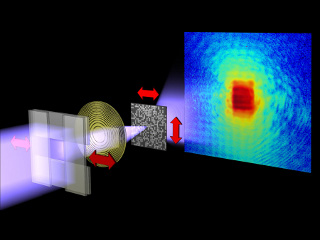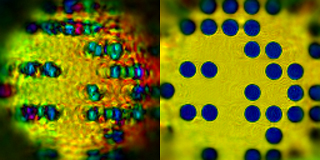Röntgenmikroskopie-Methode zeigt Fluktuationen im Inneren von Materialien
Röntgenmikroskopie-Methode zeigt Fluktuationen im Inneren von Materialien
Nachrichten aus dem Physik-Department - 2013-02-07

Mikroskopie mit Röntgenstrahlen erfordert eine extrem hohe Qualität der Strahlung. Auch Gerät und Probe dürfen sich während der Aufnahme nicht im Geringsten bewegen. Forscher der Technischen Universität München und des Paul Scherrer Instituts in Villigen (Schweiz), haben nun eine Methode entwickelt, mit der man diese Einschränkungen lockern kann. Mit ihr lassen sich sogar Fluktuationen im Material abbilden. Über ihre Ergebnisse berichtet jetzt das Fachmagazin Nature.
Seit mehr als 100 Jahren heißt es bei jeder Röntgenaufnahme: Stillhalten! Will man Nanostrukturen wie den Aufbau biologischer Zellen, die poröse Struktur von Zement oder Speicherfelder magnetischer Datenträger abbilden, müssen Probe und Röntgenmikroskop daher extrem vibrationsarm sein. Zusätzlich muss mithilfe spezieller Filter aus der ankommenden Röntgenstrahlung der Anteil mit den richtigen Eigenschaften ausgewählt werden – zum Beispiel die richtige Wellenlänge.
Beiträge verschiedener Wellenlängen getrennt
Pierre Thibault von der Technischen Universität München und Andreas Menzel, Wissenschaftler am Paul Scherrer Institut (Villigen, Schweiz), haben nun eine Methode entwickelt, die trotz Vibrationen oder Fluktuationen zuverlässige Bilder produziert. Die Methode basiert auf einer Technik namens „Ptychographie“. Sie wurde in den 1960er Jahren für die Elektronenmikroskopie entwickelt. Die Ergebnisse der Forscher ermöglichen es nun in einem Bild Effekte voneinander zu unterscheiden, die von den Lichtanteilen verschiedener Wellenlängen stammen.

Fluktuationen sichtbar gemacht
Das wahrscheinlich bedeutsamste Ergebnis der Arbeit ist, dass damit eine ganze Klasse von Objekten abgebildet werden kann, die man bisher kaum untersuchen konnte. „Wir können nicht nur Vibrationen im Mikroskop kompensieren“, sagt Andreas Menzel. „Wir können sogar Fluktuationen der Probe selber charakterisieren, auch wenn sie viel zu schnell sind, als dass wir sie mit einzelnen Momentaufnahmen festhalten könnten.“
„Um uns zu vergewissern, dass die Bilder, die wir produzierten, tatsächlich die Proben und ihre Dynamik genau wiedergaben“, sagt Pierre Thibault „führten wir Computersimulationen durch. Sie bestätigten, dass sowohl Effekte des Instruments als auch der Proben selbst, wie zum Beispiel Ströme, Schaltvorgänge oder bestimmte Quantenzustände, charakterisiert werden können.“
Mikroskopischer Blick ins Innere
Die neue Methode verbindet die Charakterisierung dynamischer Zustände mit hochauflösender Röntgenmikroskopie. Eine mögliche Anwendung besteht darin, die wechselnde Magnetisierung einzelner Bits in magnetischen Speichermedien mit hoher Speicherdichte zu untersuchen. Sichtbar gemacht werden können auch Wechselwirkungen einzelner magnetischer Bits oder ihre thermischen Fluktuationen, die letztlich die Lebensdauer magnetischer Datenspeicherung bestimmen.
„Neben dem Einsatz in bildgebenden Verfahren“, erläutert Pierre Thibault, „hat unsere Analyse aber auch eine grundlegende Verwandtschaft zu anderen Fachbereichen offenbart. Mikroskopie und Wissenschaftsdisziplinen, wie zum Beispiel Quanteninformatik, die bisher als unabhängig galten, können hierbei voneinander profitieren.”
Publikation:
Reconstructing state mixtures from diffraction measurements
Pierre Thibault, Andreas Menzel
Kontakt:
Dr. Pierre Thibault
Technische Universität München
Physik-Department, Lehrstuhl für Angewandte Biophysik (E 17)
85747 Garching, Germany
Tel.: +49 89 289 14397
E-Mail: pierre.thibault@tum.de
Links:
- Physik-Department, Lehrstuhl für Angewandte Biophysik (E 17)
- Diese Pressemeldung auf den Seiten der TUM
- Frühere Presseinformation: Röntgenbilder aus der Nanowelt der Bakterien
- Presseinformation über Anwendung der Ptychografie: Hochauflösendes Verfahren zur Nano-Computertomographie entwickelt
Redaktion: Dr. Andreas Battenberg, battenberg@zv.tum.de